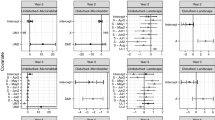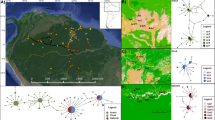Abstract
With habitat loss and fragmentation having become two of the major threats to the viability of species, the question of how to manage landscapes for species conservation has attracted much attention. In this context, the planning of stepping stones has been proposed to increase connectivity in fragmented landscapes. We present a simulation study with a neutral landscape approach to assess the effects of stepping stones on colonization success. To that end, we used a spatially explicit, calibrated population model of the European lynx (Lynx lynx) coupled with structured landscapes, in which we could control the landscape parameters of dispersal habitat coverage and contagion, as well as the number and size of stepping stones available for breeding. In general, we found that colonization success increased with increasing habitat coverage but decreased with increasing habitat contagion, while the introduction of stepping stones had significant effects in critical situations. Especially at low to medium dispersal habitat coverage and high disperser mortality, stepping stones had a positive effect on colonization success when they were large enough to produce new dispersers, but negative effects when they were small and located in a way that dispersers would be distracted from more suitable breeding habitat patches. The latter clearly constituted a shading effect and argues for a thorough consideration of the trade-offs related to stepping stone size and location when implementing stepping stones as a conservation measure, especially when the number of individuals of conservation concern is low.






Similar content being viewed by others
References
Baguette M, Van Dyck H (2007) Landscape connectivity and animal behavior: functional grain as a key determinant for dispersal. Landscape Ecol 22:1129
Baum KA, Haynes KJ, Dillemuth FP, Cronin JT (2004) The matrix enhances the effectiveness of corridors and stepping stones. Ecology 85:2671–2676
Beier P, Noss RF (1998) Do habitat corridors provide connectivity? Conserv Biol 12:1241–1252
Bender DJ, Fahrig L (2005) Matrix strucuture obscures the relationship between interpatch movement and patch size and isolation. Ecology 86:1023–1033
Bevers M, Flather CH (1999) Numerically exploring habitat fragmentation effects on populations using cell-based coupled map lattices. Theor Popul Biol 55:61–76
Boettcher M, Reck H, Haenel K, Winter A (2005) Lebensraumkorridore fuer Mensch und Natur in Deutschland. GAIA Ecol Perspect Sci Soc 14(2):163–166
Bowne DR, Bowers MA (2004) Interpatch movements in spatially structured populations: a literature review. Landscape Ecol 19:1–20
Breitenmoser U, Breitenmoser-Würsten C, Carbyn LN, Funk SM (2001) Assessment of carnivore reintroductions. In: Gittleman JL, Funk SM, Macdonald DW, Wayne R (eds) Carnivore conservation. University of Cambridge Press, Cambridge, England, pp 241–281
Chetkiewicz CL, Clair CC, Boyce MS (2006) Corridors for conservation: integrating pattern and process. Annu Rev Ecol Evol Syst 37:317–342
De’ath G, Fabricius KE (2000) Classification and regression trees: a powerful yet simple technique for ecological data analysis. Ecology 81:3178–3192
Delibes M, Ferreras P, Gaona P (2001) Attractive sinks, or how individual behavioural decisions determine source-sink dynamics. Ecol Lett 4:401–403
Fahrig L (2002) Effect of habitat fragmentation on the extinction threshold: a synthesis. Ecol Appl 12:346–353
Fahrig L (2003) Effects of habitat fragmentation on biodiversity. Annu Rev Ecol Evol Syst 34:487–515
Fahrig L (2007) Landscape heterogeneity and metapopulation dynamics. In: Wu J, Hobbs RJ (eds) Key topics and perspectives in landscape ecology. Cambridge University Press, Cambridge, UK, pp 78–89
Fischer J, Lindenmayer DB (2002) The conservation value of paddock trees for birds in a variegated landscape in southern New South Wales. 2. Paddock trees as stepping stones. Biodivers Conserv 11:833–849
Flather CH, Bevers M (2002) Patchy reaction-diffusion and population abundance: the relative importance of habitat amount and arrangement. Am Nat 159:40–56
Forman TT (1996) Land mosaics. The ecology of landscapes and regions. Cambridge University Press, New York
Gardner RH, Milne B, Turner M, O’Neill R (1987) Neutral models for the analysis of broadscale landscape pattern. Landscape Ecol 1:19–28
Gilpin ME (1980) The role of stepping stone islands. Theor Popul Biol 17:247–253
Goodwin BJ (2003) Is landscape connectivity a dependent or independent variable? Landscape Ecol 18:687–699
Goodwin BJ, Fahrig L (2002) How does landscape structure influence landscape connectivity? Oikos 99:552–570
Grimm V, Revilla E, Berger U, Jeltsch F, Mooij WM, Railsback SF, Thulke H-H, Weiner J, Wiegand T, DeAngelis DL (2005) Pattern-oriented modeling of agent-based complex systems: lessons from ecology. Science 310:987–991
Hanski I (1994) A practical model of metapopulation dynamics. J Anim Ecol 63:151–162
Hein S, Pfenning B, Hovestadt T, Poethke H-J (2004) Patch density, movement pattern, and realised dispersal distances in a patch-matrix landscape—a simulation study. Ecol Model 174:411–420
Heinz SK, Conradt L, Wissel C, Frank K (2005) Dispersal behaviour in fragmented landscapes: deriving a practical formula for patch accessibility. Landscape Ecol 20:83–99
Heinz SK, Wissel C, Frank K (2006) The viability of metapopulations: individual dispersal behaviour matters. Landscape Ecol 21:77–89
Hobbs RJ (1992) The role of corridors in conservation: solution or bandwagon? Trends Ecol Evol 7:389–392
Hurford A, Hebblewith M, Lewis MA (2006) A spatially explicit model for an Allee effect: why wolves recolonize so slowly in Greater Yellowstone. Theor Popul Biol 70:244–254
Jepsen JU, Baveco JM, Topping CJ, Verboom J, Vos CC (2005) Evaluating the effect of corridors and landscape heterogeneity on dispersal probability: a comparison of three spatially explicit modelling approaches. Ecol Model 181:445–459
Kramer-Schadt S, Revilla E, Wiegand T, Breitenmoser U (2004) Fragmented landscapes, road mortality and patch connectivity: modelling influences on the dispersal of Eurasian lynx. J Appl Ecol 41:711–723
Kramer-Schadt S, Revilla E, Wiegand T (2005) Lynx reintroductions in fragmented landscapes of Germany: projects with a future or misunderstood wildlife conservation? Biol Conserv 125:169–182
Kramer-Schadt S, Revilla E, Wiegand T, Grimm V (2007) Patterns for parameters in simulation models. Ecol Model 204:553–556
Lindenmayer DB, Fischer J (2007) Tackling the habitat fragmentation panchreston. Trends Ecol Evol 22:127–132
Lindenmayer D, Hobbs RJ, Montague-Drake R, Alexandra J, Bennett A (2008) A checklist for ecological management of landscapes for conservation. Ecol Lett 11:78–91
Naves J, Wiegand T, Revilla E, Delibes M (2003) Endangered species constrained by natural and human factors: the case of brown bears in Northern Spain. Conserv Biol 17:1276–1289
Reck H, Hänel K, Böttcher M, Winter A (2006) Lebensraumkorridore für Mensch und Natur—Initiativskizze. Naturschutz und Biologische Vielfalt 17:11–53
Revilla E, Wiegand T (2008) Individual movement behavior, matrix heterogeneity and the dynamics of spatially structured populations. PNAS 105:19120–19125
Revilla E, Wiegand T, Palomares F, Ferreras P, Delibes M (2004) Effects of matrix heterogeneity on animal dispersal: from individual behavior to metapopulation-level parameters. Am Nat 164:E130–E153
Schadt S, Knauer F, Kaczensky P, Revilla E, Wiegand T, Trepl L (2002a) Rule-based assessment of suitable habitat and patch connectivity for the Eurasian lynx in Germany. Ecol Appl 12:1469–1483
Schadt S, Revilla E, Wiegand T, Knauer F, Kaczensky P, Breitenmoser U, Bufka L, Cerveny J, Koubek P, Huber T, Stanisa C, Trepl L (2002b) Assessing the suitability of central European landscapes for the reintroduction of Eurasian lynx. J Appl Ecol 39:189–203
Schultz CB (1998) Dispersal behavior and its implications for reserve design in a rare Oregon butterfly. Conserv Biol 12:284–292
Simberloff D, Farr JA, Cox J, Mehlmann PW (1992) Movement corridors: conservation bargains or poor investments? Conserv Biol 6:493–505
Söndgerath D, Schröder B (2002) Population dynamics and habitat connectivity affecting the spatial spread of populations—a simulation study. Landscape Ecol 00:1–14
Sutherland WJ, Armstrong-Brown S, Armsworth PR, Brereton T, Brickland J, Campbell CD, Chamberlain DE, Cooke AI, Dulvy NK, Dusic NR, Fitton M, Freckleton RP, Godfray HCJ, Grout N, Harvey HJ, Hedley C, Hopkin JJ, Kift NB, Kirby J, Kunin WE, MacDonald DW, Marker B, Naura M, Neale AR, Oliver T, Osborn D, Pullin AS, Shardlow MEA, Showler DA, Smith PL, Smithers RJ, Solandt JL, Spencer J, Spray CJ, Thomas CD, Thompson J (2006) The identification of 100 ecological questions of high policy relevance in the UK. J Appl Ecol 43:617–627
Taylor PD, Fahrig L, With KA (2006) Landscape connectivity: a return to the basics. In: Crooks KR, Sanjayan M (eds) Connectivity conservation. Cambridge University Press, Cambridge, UK, pp 29–43
Tischendorf L, Fahrig L (2000a) How should we measure landscape connectivity? Landscape Ecol 15:633–641
Tischendorf L, Fahrig L (2000b) On the usage and measurement of landscape connectivity. Oikos 90:7–19
Uezu A, Beyer DD, Metzger JP (2008) Can agroforest woodlots work as stepping stones for birds in the Atlantic forest region? Biodivers Conserv 8:1907–1922
Vance MD, Fahrig L, Flather CH (2003) Effect of reproductive rate on minimum habitat requirements of forest-breeding birds. Ecology 84:2643–2653
Villard MA (2002) Habitat fragmentation: major conservation issue or intellectual attractor? Ecol Appl 12:319–320
Vogt P, Ferrari JR, Lookingbill TR, Gardner RH, Riitters KH, Ostapowicz K (2009) Mapping functional connectivity. Ecol Indic 9:64–71
Wiegand T, Moloney KA, Naves J, Knauer F (1999) Finding the missing link between landscape structure and population dynamics: a spatially explicit perspective. Am Nat 154:605–627
Wiegand T, Jeltsch F, Hanski I, Grimm V (2003) Using pattern-oriented modelling for revealing hidden information: a key for reconciling ecological theory and conservation practice. Oikos 100:209–222
Wiegand T, Knauer F, Kaczensky P, Naves J (2004a) Expansion of brown bears (Ursus arctos) into the eastern Alps: a spatially explicit population model. Biodivers Conserv 13:79–114
Wiegand T, Revilla E, Knauer F (2004b) Reducing uncertainty in spatially explicit population models. Biodivers Conserv 13:53–78
Wiegand T, Revilla E, Moloney KA (2005) Effects of habitat loss and fragmentation on population dynamics. Conserv Biol 19:108–121
Wilcox BA, Murphy DD (1985) Conservation strategy: the effects of fragmentation on extinction. Am Nat 125:879–887
Wilson EO, Willis EO (1975) Applied biogeography. In: Cody ML, Diamond JM (eds) Ecology and evolution of communities. Harvard University Press, Cambridge, Massachusetts, USA, pp 522–534
With KA (1997) The application of neutral landscape models in conservation biology. Conserv Biol 11:1069–1080
Acknowledgements
SKS is supported by a Marie Curie Individual Fellowship provided by the EU (MEIF-CT-2006-039985).
Author information
Authors and Affiliations
Corresponding author
Electronic supplementary material
Below is the link to the electronic supplementary material.
Rights and permissions
About this article
Cite this article
Kramer-Schadt, S., S. Kaiser, T., Frank, K. et al. Analyzing the effect of stepping stones on target patch colonisation in structured landscapes for Eurasian lynx. Landscape Ecol 26, 501–513 (2011). https://doi.org/10.1007/s10980-011-9576-4
Received:
Accepted:
Published:
Issue Date:
DOI: https://doi.org/10.1007/s10980-011-9576-4




